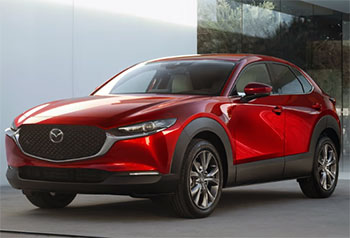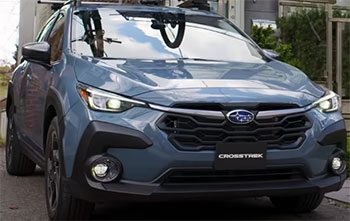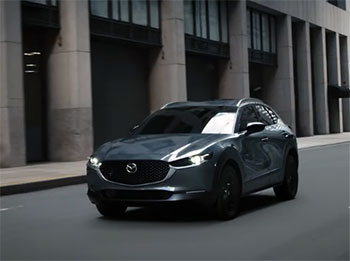I’ve always been drawn to compact SUVs for their blend of practicality, style, and versatility. When I set out to compare the 2025 Mazda CX-30 and Subaru Crosstrek, my goal was to find which one suits my lifestyle—and maybe yours too. Both vehicles promise a lot: sleek designs, all-wheel drive, and modern tech.
But which one delivers the best balance of fun, comfort, and utility? In this article, I’ll share my firsthand experiences, break down their strengths and weaknesses, and help you decide which SUV fits your needs. Let’s get started with a side-by-side comparison.
Comparison Table: Mazda CX-30 vs. Subaru Crosstrek
| Feature | Mazda CX-30 | Subaru Crosstrek |
|---|---|---|
| Starting MSRP | $26,690 | $27,980 |
| Base Engine | 2.5L 4-cylinder, 191 hp | 2.0L 4-cylinder, 152 hp |
| Optional Engine | 2.5L Turbo, 250 hp | 2.5L 4-cylinder, 182 hp |
| Fuel Economy (city/hwy) | 26/33 mpg (base), 22/30 mpg (turbo) | 27/34 mpg (base), 26/33 mpg (2.5L) |
| Cargo Space | 20.2 cu. ft. (seats up), 45.2 cu. ft. (seats folded) | 19.9 cu. ft. (seats up), 54.9 cu. ft. (seats folded) |
| Passenger Volume | 94 cu. ft. | 100.5 cu. ft. |
| Ground Clearance | 8.0 inches | 8.7 inches |
| Infotainment | 8.8-inch display, rotary knob | Dual 7-inch or 11.6-inch touchscreen |
| Safety Features | Standard blind-spot monitor, lane-keep assist | Standard EyeSight suite (adaptive cruise, lane centering) |
| Reliability (J.D. Power) | 80/100 | 83/100 |
| IIHS Safety Rating | Top Safety Pick+ | Top Safety Pick |
My Experience With the Mazda CX-30

Driving the 2025 Mazda CX-30 felt like slipping into a sports sedan disguised as an SUV.
The first thing that struck me was its sleek design—Mazda’s KODO philosophy gives it flowing lines and a premium vibe that stands out in a crowded parking lot.
Inside, the cabin feels like a step above its price point, with soft-touch materials and a driver-focused layout.
The 2.5-liter base engine, pumping out 191 horsepower, made city driving a breeze, and the optional turbo (250 hp) turned twisty backroads into a playground.
The six-speed automatic shifted smoothly, and the steering was razor-sharp, making every turn feel precise.
On a weekend trip to the mountains, the CX-30’s all-wheel-drive system handled wet roads confidently, though I noticed it took a moment to find grip in deeper mud compared to some competitors. The infotainment system, controlled by a rotary knob, took some getting used to, but I appreciated not having to smudge a touchscreen.
The Bose 12-speaker audio system (available on higher trims) was a highlight, turning my playlist into a concert. However, the rear seats felt snug for taller passengers, and visibility wasn’t great due to the thick A-pillars. Overall, the CX-30 felt like a car built for drivers who crave a bit of excitement without sacrificing practicality.
Pros Of the Mazda CX-30
- Sporty Handling: The CX-30 drives like a Mazda 3 hatchback, with crisp steering and minimal body roll, making it a joy on winding roads. It’s easily the most engaging subcompact SUV I’ve driven.
- Premium Interior: The cabin feels near-luxury, with leatherette or leather options as early as the second trim. The blue-and-cream color scheme on higher trims looks straight out of a German showroom.
- Powerful Engine Options: The base 2.5-liter engine (191 hp) is strong for the class, and the turbocharged version (250 hp) delivers thrilling acceleration, hitting 60 mph in about 5.8 seconds.
- Standard Safety Features: Blind-spot monitoring, lane-keep assist, and adaptive cruise control come standard, earning the CX-30 an IIHS Top Safety Pick+ rating.
- Upscale Technology: The available 10.25-inch infotainment display, 12-speaker Bose audio, and heated steering wheel (on Turbo Premium trims) add a touch of luxury not found in many rivals.
- Fuel Efficiency for Power: Even with the base engine, the CX-30 gets 26/33 mpg city/highway, competitive for an AWD SUV with this much pep.
- Customization Options: Eight trim levels let you tailor the CX-30 to your needs, from budget-friendly to near-luxury, with features like a power moonroof and Alexa integration.
The CX-30’s driving dynamics were a standout during my test. On a curvy road near my home, it hugged corners with confidence, and the suspension soaked up bumps without feeling harsh. The interior’s attention to detail—like the soft fade of the turn signal repeaters—made every drive feel special.
The turbo engine transformed the CX-30 into a pocket rocket, perfect for passing slower traffic. Safety features gave me peace of mind, especially the standard blind-spot monitor, which was a lifesaver during rush-hour lane changes. If you love driving and want an SUV that feels premium without breaking the bank, the CX-30 delivers.
Cons Of the Mazda CX-30
- Limited Rear Visibility: The thick A-pillars and small rear windows made it hard to see in certain situations, like merging onto highways. I relied heavily on the blind-spot monitor to compensate.
- Cramped Rear Seats: At 6 feet tall, I found the second row tight, with only 36.3 inches of legroom. Taller passengers complained during longer trips.
- Smaller Cargo Space: With 20.2 cubic feet behind the rear seats, the CX-30 has less cargo room than some rivals, like the Subaru Crosstrek’s 54.9 cubic feet with seats folded.
- Learning Curve for Infotainment: The rotary knob for the 8.8-inch display isn’t as intuitive as a touchscreen, especially for passengers trying to adjust settings.
- Slightly Stiff Ride: The sporty suspension can feel firm on rough roads, which might bother those prioritizing comfort over handling.
- Lower Ground Clearance: At 8.0 inches, the CX-30’s ground clearance is less than the Crosstrek’s 8.7 inches, limiting its off-road capability.
- Premium Fuel for Turbo: The turbocharged engine recommends premium fuel, which could increase costs for performance-minded drivers.
The visibility issue was noticeable during my test drives, especially at intersections where the A-pillar blocked my view of oncoming traffic. I added convex mirrors to the side mirrors, which helped. The rear seats were fine for short trips, but a friend over 6 feet felt cramped on a two-hour drive.
Cargo space was adequate for groceries or weekend gear, but I struggled to fit larger items like a stroller without folding the seats. The infotainment system frustrated my passenger, who fumbled with the knob to change music. If you need more space or off-road prowess, these drawbacks might steer you elsewhere.
My Experience With the Subaru Crosstrek

The 2025 Subaru Crosstrek has a rugged charm that won me over the moment I saw its bright yellow paint option.
It’s less polished than the CX-30 but feels built for adventure. The cabin is functional, with big, clear buttons and an 11.6-inch touchscreen (on higher trims) that’s easy to use.
The base 2.0-liter engine (152 hp) felt underpowered on highways, but the 2.5-liter (182 hp) was a better match for my needs.
Subaru’s symmetrical all-wheel-drive system shone during a snowy drive, gripping the road effortlessly with its 8.7 inches of ground clearance.
I took the Crosstrek on a dirt trail, and its X-Mode system made light work of muddy patches, outpacing the CX-30’s off-road ability.
The EyeSight safety suite, standard on CVT models, kept me confident with adaptive cruise control and lane centering.
However, the interior materials felt a bit budget-conscious, and the CVT transmission wasn’t as smooth as the CX-30’s automatic. Cargo space was a plus, with 54.9 cubic feet available with seats folded. The Crosstrek felt like a trusty companion for outdoor enthusiasts, but it lacked the CX-30’s refinement.
Pros Of the Subaru Crosstrek
- Superior Off-Road Capability: The Crosstrek’s 8.7-inch ground clearance and X-Mode system make it a champ on dirt trails and snowy roads, perfect for adventurous drivers.
- Standard All-Wheel Drive: Subaru’s symmetrical AWD is always active, providing excellent traction in all conditions, especially in rain or snow.
- Spacious Interior: With 100.5 cubic feet of passenger volume, the Crosstrek offers more legroom (42.9 inches front, 36.5 inches rear) than the CX-30, ideal for taller passengers.
- Better Fuel Economy: The base engine achieves 27/34 mpg city/highway, slightly edging out the CX-30, and the larger 16.6-gallon tank means fewer stops.
- Robust Safety Suite: The EyeSight system includes adaptive cruise control, lane-keep assist, and automatic emergency braking, earning a Top Safety Pick rating.
- Cargo Versatility: With 54.9 cubic feet of cargo space (seats folded), the Crosstrek beats the CX-30 for hauling gear, and the roof rails add extra utility.
- Proven Reliability: A J.D. Power score of 83/100 and Subaru’s reputation for durability make the Crosstrek a dependable choice for long-term ownership.
The Crosstrek’s off-road prowess was a game-changer during my test in a snowy, rural area. X-Mode adjusted torque and traction seamlessly, letting me tackle a slippery hill without breaking a sweat. The spacious interior was a hit with my friends, who appreciated the extra legroom on a group trip. The EyeSight system smoothed out highway driving, though it occasionally over-corrected during lane changes. The larger cargo area easily swallowed camping gear, and the roof rails were perfect for my bike. If you live in a snowy region or love outdoor adventures, the Crosstrek’s ruggedness is hard to beat.
Read More: My Thoughts On Ford Escape Vs. Mazda CX-5
Cons Of the Subaru Crosstrek
- Underpowered Base Engine: The 2.0-liter engine (152 hp) feels sluggish, especially on highways, requiring patience for passing or merging.
- Budget Interior Materials: The cabin’s hard plastics and cloth seats (even in mid-tier trims) feel less premium than the CX-30’s upscale design.
- CVT Transmission: The continuously variable transmission can feel rubbery and less responsive than the CX-30’s six-speed automatic, detracting from the driving experience.
- Outdated Infotainment Graphics: The dual 7-inch screens (base models) or even the 11.6-inch touchscreen have laggy software and dated visuals compared to rivals.
- Limited Luxury Features: No heated steering wheel or premium audio options like the CX-30’s Bose system; leather upholstery is only on the Limited trim.
- Noisy Cabin: Engine and road noise are more noticeable than in the CX-30, especially at highway speeds, which can make long drives less pleasant.
- Higher Starting Price: At $27,980, the Crosstrek is pricier than the CX-30 ($26,690), which offers more power and refinement for less.
The base engine was a letdown during my highway test, struggling to keep up with traffic. The CVT’s droning noise didn’t help, making acceleration feel labored. The interior, while spacious, lacked the CX-30’s polish—hard plastics and basic cloth seats felt like a step down. The infotainment system was intuitive but sluggish, and the graphics looked a generation behind. I also missed luxury touches like a heated steering wheel, which the CX-30 offers. For urban drivers who prioritize refinement, the Crosstrek’s utilitarian vibe might feel like a compromise.
Diving Deeper: Performance and Driving Dynamics

Let’s talk about how these SUVs feel on the road. The Mazda CX-30 is the driver’s choice, hands down. Its suspension is tuned for agility, and the steering feels like an extension of your thoughts. During a spirited drive on a winding country road, the CX-30’s body control was impressive, with minimal lean in corners. The turbo engine (available on higher trims) turned it into a thrill machine, shaving seconds off acceleration compared to the base model. However, the trade-off is a firmer ride, which I noticed on pothole-ridden city streets. It’s not harsh, but it’s less cushioned than some rivals.
The Subaru Crosstrek, by contrast, leans into comfort and capability. Its softer suspension soaked up bumps better, making it ideal for long drives or rough roads. On a snowy trail, the Crosstrek’s AWD and higher ground clearance gave me confidence where the CX-30 hesitated. But on pavement, the Crosstrek’s looser steering and noticeable body roll made it less engaging. The 2.5-liter engine improved performance, but it still lagged behind the CX-30’s zippy base engine. If you prioritize fun behind the wheel, the CX-30 wins; if you need all-weather versatility, the Crosstrek shines.
Interior Comfort and Technology
Inside, the CX-30 feels like a premium car. The seats are supportive, the steering wheel is perfectly sized, and the materials rival brands costing thousands more. The 8.8-inch infotainment display (upgradable to 10.25 inches) looks sleek, but the rotary knob took me a few drives to master. Features like the Bose audio system and heated steering wheel (on Turbo trims) made me feel pampered. However, the rear seats and cargo area felt snug, and the small windows made the cabin feel a bit closed-in.
The Crosstrek’s interior is all about function. The spacious cabin accommodated my taller friends comfortably, and the large touchscreen was easy to navigate. Apple CarPlay and Android Auto worked flawlessly, but the graphics felt dated. The lack of premium options—like a high-end audio system or heated steering wheel—was noticeable. The Crosstrek’s roof rails and larger cargo area were practical for my outdoor gear, but the cabin’s noise level and basic materials didn’t match the CX-30’s refinement. If luxury matters to you, the CX-30 is the clear winner; for practicality, the Crosstrek takes it.
Safety and Reliability
Both SUVs prioritize safety, but they approach it differently. The CX-30’s standard features include blind-spot monitoring, lane-keep assist, and adaptive cruise control, earning it an IIHS Top Safety Pick+ rating. The 360-degree camera (available on higher trims) was a godsend in tight parking lots. The Crosstrek’s EyeSight suite is equally impressive, with adaptive cruise control, lane centering, and automatic emergency braking. Its Top Safety Pick rating is solid, though it falls short of the CX-30’s plus designation. Both felt safe, but the CX-30’s crash test scores gave me extra confidence.
Reliability-wise, the Crosstrek edges out with a J.D. Power score of 83/100 compared to the CX-30’s 80/100. RepairPal rates Mazda slightly higher (4/5 vs. 3.5/5 for Subaru), but Subaru’s reputation for durability is well-earned. My test drives didn’t reveal any mechanical issues, but the Crosstrek’s simpler design felt like it could withstand years of abuse. If longevity is your top concern, the Crosstrek might have a slight advantage.
Off-Road and All-Weather Performance
The Crosstrek is the go-to for off-road enthusiasts. Its 8.7-inch ground clearance and X-Mode system made light work of a muddy trail I tested. The symmetrical AWD system is always active, ensuring grip in rain, snow, or gravel. I felt unstoppable in a snowstorm, with the Crosstrek plowing through slush without slipping. The CX-30’s i-ACTIV AWD is capable but less aggressive, and its 8.0-inch ground clearance limited my confidence on rough terrain. For city drivers or those in milder climates, the CX-30 is fine, but the Crosstrek is the better choice for rugged adventures.
Pricing and Value
The CX-30 starts at $26,690, undercutting the Crosstrek’s $27,980. For the price, the CX-30 offers more power and premium features, like leatherette seats and a standard blind-spot monitor. The Crosstrek’s higher trims, like the Limited, add leather but skip niceties like a heated steering wheel. Both offer strong value, but the CX-30 feels like a better deal for urban drivers who want refinement. The Crosstrek’s resale value is stronger (27% depreciation vs. 34.1% for the CX-30 over five years), making it a smarter long-term investment for some.
Making the Choice: Lifestyle Fit
Your lifestyle will dictate which SUV suits you. The CX-30 is perfect for city dwellers who love driving and want a touch of luxury. Its sporty handling and upscale interior make daily commutes enjoyable, but the tight rear seats and limited cargo space might frustrate families. The Crosstrek is ideal for outdoor enthusiasts or those in snowy regions. Its off-road capability and spacious interior are practical, but the lackluster base engine and basic cabin might disappoint those seeking refinement. Test-driving both helped me clarify my priorities—fun driving vs. rugged utility.
Read More: My Thoughts On Acura MDX Vs. Volvo XC90
Frequently Asked Questions (FAQ)
It depends on your needs. The CX-30 is better for sporty driving and premium interiors, while the Crosstrek excels in off-road capability and interior space.
The CX-30’s main weaknesses are limited rear visibility, cramped rear seats, and smaller cargo space compared to rivals like the Crosstrek.
The CX-30 is comparable to the Subaru Crosstrek, Honda HR-V, Toyota Corolla Cross, and Kia Seltos in the subcompact SUV segment.
The CX-30’s popularity stems from its sporty handling, upscale interior, strong safety ratings, and competitive pricing, appealing to drivers seeking value and style.
Conclusion: For Mazda CX-30 and Subaru Crosstrek
You can’t go wrong with either the Mazda CX-30 or Subaru Crosstrek, but they cater to different vibes. If you’re like me and love a car that feels sporty and upscale, the CX-30’s sharp handling and premium cabin will make you smile. It’s perfect for urban adventures and twisty roads. But if you’re chasing trails or braving snowy winters, the Crosstrek’s off-road prowess and spacious interior are tough to beat. Test-drive both to see which fits your life—you’ll find the one that feels like home.

